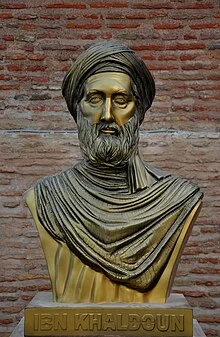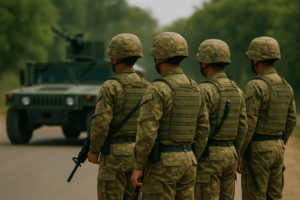Ibn Khaldun
Ibn Khaldun (1332-1406) was a Tunisian scholar who traveled widely across the Muslim world and wrote one of the most famous of all historical works, the Kitab al-Ibar, of which the Introduction has been translated into English as The Muqaddimah.
He received an excellent education but was orphaned at the age of 16 when his parents and much of his family succumbed to the Black Death. He worked as an administrator and consultant in government at courts in Morocco and Granada in Spain.
After a series of political intrigues that landed him in prison, he withdrew from political life and began to study the social conditions of the semi-nomadic peoples in the neighboring regions of the Sahara. He compiled regional histories and set out to develop a type of comparative history.
Ibn Khaldun developed a theory about the rise and fall of dynasties and the importance of Asabiya or group feeling or solidarity as a factor in sociology. He also worked as a judge in Cairo.
Ibn Khaldun defines the downfall as a usual process and says that states, dynasties, nations, and civilizations are like humans so they are born, grow, die and others take over their places and they face the same results and this process repeats itself time and again.
Ibn Khaldun also further states in the Muqaddimah that “dynasties have a natural life span like individuals”, and that no dynasty generally lasts beyond three generations of about 40 years each.
Ibn Khaldun was noted for developing one of the earliest nonreligious philosophies of history. He is generally considered the greatest Arab historian as well as the father of sociology and the science of history.
What is Asabiya
Asabiyyah or Asabiya, also known as “group feeling” or “social cohesion,” is a concept deeply rooted in the notion of solidarity and unity within a society. Originating in the context of tribalism and clanism, ‘asabiyyah emphasizes the importance of shared purpose and collective consciousness among members of a group.
Contrary to popular belief, ‘asabiyyah is not solely based on nomadic lifestyles or blood relations. Instead, it embodies principles akin to classical republicanism, emphasizing the collective welfare and unity of the community.
In contemporary times, ‘asabiyyah is often equated with solidarity, although it can carry negative connotations, particularly when associated with nationalism or blind partisanship. This suggests loyalty to one’s group regardless of external circumstances or moral considerations.
The concept of ‘asabiyyah gained prominence through Ibn Khaldun’s seminal work, the Muqaddimah. In his writings, Ibn Khaldun portrays ‘asabiyyah as the fundamental bond of human society and a driving force in historical development. He argued that ‘asabiyyah follows a cyclical pattern, waxing strongest at the inception of a civilization, diminishing as it progresses, and eventually giving way to a new, more potent form of social cohesion that lays the foundation for a different civilization. Thus, ‘asabiyyah plays a pivotal role in the rise and fall of civilizations, shaping their trajectory over time.
Ibn-e-Khaldun Concept of Asabiya
The 14th-century historian, economist, and sociologist Ibn Khaldun analyzed the economic, social, and political development of organized societies systematically. He describes asabiyya as the bond of cohesion among humans in a group-forming community.
Asabiyyah or ‘asabiyya ascribes group feeling or social cohesion as a concept of social solidarity with an emphasis on unity, group consciousness, and a sense of shared purpose. The term is originally used in the context of tribalism and clanism. In the modern period, it is generally analogous to solidarity.
Ibn Khaldun’s concept of ‘asabiyyah elucidates the bond of cohesion inherent within human communities, regardless of their level of civilization, spanning from nomadic societies to established states and empires. Notably, ‘asabiyyah reaches its zenith during the nomadic phase and gradually wanes as civilization progresses. As this decline occurs, Ibn Khaldun posits that another, more compelling form of ‘asabiyyah may emerge, leading to the rise and fall of civilizations, a cyclical pattern that permeates history.
Central to Ibn Khaldun’s thesis is the idea that every dynasty or civilization contains the seeds of its own demise. He illustrates how ruling houses often originate on the peripheries of existing empires, harnessing the potent ‘asabiyyah prevalent in their regions to challenge established leadership. Initially perceived as “barbarians” in comparison to their predecessors, these new rulers ascend to power by exploiting the strength of their ‘asabiyyah. However, as they consolidate their control at the empire’s center, they gradually succumb to complacency, losing the discipline and vigilance that characterized their ascent. Consequently, their ‘asabiyyah diminishes, giving way to factionalism and individualism, thus weakening their political cohesion.
According to Ibn Khaldun, this internal decay sets the stage for the emergence of a new dynasty at the empire’s periphery, initiating a cycle of rise and fall. He astutely observes that dynasties, like individuals, have a natural lifespan, typically lasting no more than three generations, or approximately 40 years each. This cyclical nature of dynastic longevity underscores the inevitability of change and succession in human societies, as exemplified by the perpetual ebb and flow of ‘asabiyyah throughout history.
In Ibn Khaldun’s Muqaddimah, in which it is described as the fundamental bond of human society and the basic motive force of history, pure only in its nomadic form. Ibn Khaldun argued that asabiyya is cyclical and directly relevant to the rise and fall of civilizations: it is strongest at the start of civilization, declines as the civilization advances, and then another more compelling asabiyyah eventually takes its place to help establish a different civilization.
Ibn Khaldun describes asabiyya as the bond of cohesion among humans in a group-forming community. The bond exists at any level of civilization, from nomadic societies to states and empires. Asabiyyah is strongest in the nomadic phase and decreases as civilization advances. As this declines, another more compelling Asabiyyah may take its place; thus, civilizations rise and fall, and history describes these cycles as they play out.
He divides civilization into two – nomadic/rural and sedentary/urban – and explains how there is a movement from one to the other, that is, a transition from umran badawi (rural) to umran hadari (urban). Umran, in Ibn Khaldun’s view, is not something fixed or an artifact but rather a dynamic process.
Humans by nature, asserts Ibn Khaldun, are social beings who favor collective existence over individual living and therefore opt for living together, cooperating with one another, and being assistance to each other.
He says, “… human beings cannot live and exist except through social organization and co-operation for the purpose of obtaining their food and other necessities of life.
An ongoing example is the case of Israel. The secular Zionist movement which brought it into existence built a strong clannish asabiyya between disparate groups by means of shared suffering, tradition, and the ‘armed citizen’. This allowed it to soundly defeat overwhelming Arab forces whose internal divisions and social-tribal incoherence between elites and soldiers made an ineffective fighting force. Today, the Zionist vision of a secular Israel is as inevitable trembling the onset of the loss of asabiyya, with the emergent religious population – once a harmless, ‘backward’ fringe element – having both a solid group feeling and a keen awareness of its interests. While the future is ever up for grabs, this already presents a strong challenge to the old order.
📍 English Language Educator | Blogger & Content Strategist | 7+ Years in Educational Blogging
Nosheen Bashir is a dedicated English teacher and experienced blogger with over seven years of expertise in content creation and educational writing. Passionate about language, literature, and effective communication, she combines her teaching experience with blogging skills to create insightful, research-backed content that helps learners and educators alike.
🔹 Expertise & Achievements:
✔ English Language Education: A skilled educator with years of experience in teaching English grammar, literature, and communication skills to students of varying levels.
✔ Educational Blogging: Running a successful blog for 7+ years, delivering well-structured, engaging content on language learning, writing techniques, and academic success.
✔ SEO & Content Strategy: Specializes in creating high-ranking, authoritative articles that follow Google’s EEAT principles, ensuring content that is both informative and search-friendly.
✔ Student-Centric Approach: Committed to making English easier, engaging, and accessible, helping readers and students improve their language proficiency.
🚀 With a passion for teaching and writing, Nosheen Bashir is dedicated to crafting educational content that empowers students, teachers, and language enthusiasts worldwide.










